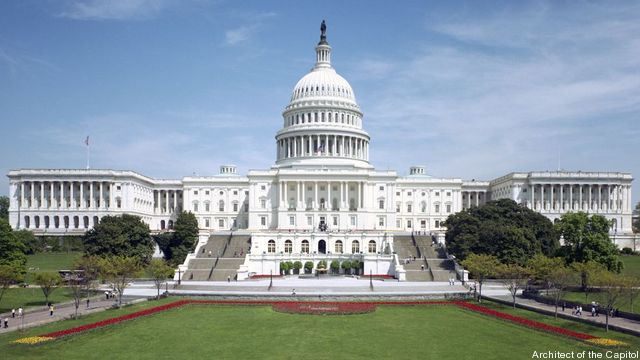What Really Matters In The Defense Authorization Act & What Didn’t Get Done
Posted on

Most coverage of the annual defense policy bill has focused on program changes: more ships (including six icebreakers!), no change to F-35’s, more RDT&E, no JSTARS recap, a growl (but no more) on ZTE, and many more (the bill and report run 2,500 pages). Less discussed, but of more import in the long run, are the National Defense Authorization Act’s organizational, strategy and process changes. Here’s what really matters.
Tougher Attitudes On China and Russia
Driven in part by a new National Defense Strategy that focuses on long-term competition with Russia and China, and in part by concerns that the president may be too lenient towards Russia, the National Defense Authorization Act contains several provisions that show a hardening of congressional attitude. It enshrines in law the exclusion of China from RIMPAC (the annual Pacific exercise that includes large numbers of allies and partners), although it does allow for a waiver by the Defense Secretary.

Mark Cancian
It prohibits the use of Confucian Institutes for language training (these are closely linked to the Chinese government), and makes more explicit US support for Taiwan. The law also requires that the annual report to Congress on China include details about Chinese espionage, the state of relations between China and Russia and efforts by China to influence US citizens.
On Russia, it continues limitations on military cooperation, prohibits any recognition of the annexation of Crimea, highlights concerns over treaty violations, and expresses the sense of Congress about the need to enhance deterrence. Despite questions about the effects of Trump’s personal diplomacy, a bipartisan consensus has solidified that Russia and China are long-term competitors and that the US must act accordingly.
Special Operations
Congress has slowly and consciously restructured special operations as an independent service. The assistant Defense Secretary for special operations and low intensity conflict now has duties similar to those of a service secretary, and the commander of Special Operations Command has duties similar to those of a service chief.
The NDAA adds civilians to SOLIC — at a time when other headquarters are being reduced — for the purpose of supporting “service secretary-like” civilian responsible for exercising “authority, direction and control of all special operations-peculiar administrative matters relating to the organization, training, and equipping of special operations forces.” It also directs acceleration of previous organizational changes giving both the assistant secretary and the SOCOM commander more authority over special operations personnel and organizations. So far, the military services have gone along with such changes, but, as special operations forces become increasingly independent of their parent services, the services might regard their support as a “tax” and ask tough questions.
In a clear indication that this may become permanent Congress also ordered a “comprehensive review” of SOCOM, as well as a separate look at “whether the joint force would benefit from having one Armed Force dedicated primarily to low-intensity missions, thereby enabling the other Armed Forces to focus more exclusively on advanced peer competitors.”
Paying For War
War funding (Overseas Contingency Operations, OCO) has long been controversial, criticized as a “slush fund” that allows “back door” increases to defense spending. The reality, as discussed here previously, is more complicated, but OCO is an anomaly in budgeting. The administration, in its FY 2019 budget, projected that in FY 2020 and beyond it would move $50 billion of enduring costs—that is, costs that would continue after forces left Iraq and Afghanistan—from OCO to the base with a commensurate increase in base funding. The NDAA seems to support that move with the requirement to report on the amount of enduring costs in OCO every year beginning in FY 2020. So there could be real change in how conflicts are funded.
Budget And National Defense Strategy
The Senate, in particular, argued that “much of the hardest work remains to translate the NDS into detailed policy guidance to realign defense programs, readiness, and posture in accordance with the strategy….We must make difficult choices about roles and missions, force development, resource allocation, and investment priorities. This responsibility rests equally with the executive and legislative branches.” Consistent with this, the NDAA increases procurement by $1.8 billion and R&D by $700 million over what the president had requested. These are paid for by unspecified reductions for “under execution” of prior year funding and some shifting of OCO funding. There are many increases—hypervelocity missiles, directed energy weapons, cruise missile defense, carrier modifications to support UAVs, long-range munitions, more aggressive ballistic missile defense, to cite only a few—all aimed at enhancing capabilities for high-end conflicts that the NDS envisions. These are only the beginning of budgetary changes that reflect the shift in strategy from regional conflicts and counterinsurgency to great power conflicts.
Changes To Military Personnel Careers
The NDAA makes many changes to the 30-year-old Defense Officer Personnel Management Act (DOPMA). Aimed at making the military more competitive in the “war for talent”, these changes give the services more flexibility in hiring and promoting. They look a lot like the “Force of the Future” that the Obama administration had proposed. For example, the services would be authorized to make temporary promotions in critical career fields, promote some officers early, exempt some officers from promotion boards (which has the effect of allowing them to bypass the up-or-out system), and continue service to 40 years (10 years beyond the current 30 years). The NDAA repeals age-based officer appointment requirements. The career intromission program, whereby officers can take time out of military service to do something else, is made permanent. The effect of these changes will depend on how extensively the services use them. The upside is that the services may finally fill certain skill communities like cyber. The downside is that widespread use will make the military services look more like civilian organizations and dilute their warfighting focus.
The Misfires
The Senate, frustrated about the disconnect between the budget and the administration’s new strategy, did not get what it wanted in the bill. In its version of the NDAA, the Senate had a 15-page scope of work for a Roles and Missions Report on the implications of the new strategy. Obviously, the Senate had very specific issues it wanted DoD to focus on.
Two themes jumped out: the need to move from manned to unmanned aircraft, and skepticism about the viability of amphibious assaults in a high-threat environment. The former caught the attention of aviators; the latter caught the attention of Marines. There was apparently strong push back from the House and little of this made it into the final bill. What remained was a much briefer, though broad Roles and Missions Report that included direction that DOD brief the Congress on implementation guidance that it was giving to its subordinate elements (called the Defense Programming Guidance and the Guidance for Employment of the Force). However, the Senate’s ire has not abated and will likely pop up again next year.
For its part, the House did not see its frustration about the size of defense agencies addressed. As Breaking Defense readers know, the House tried to eliminate some defense agencies and to cut overall agency personnel by 25 percent. This arose from frustration that “defense–wide” accounts had grown to 18% of the budget but that these centralized activities had lost responsiveness to their customers and were not getting the kind of scrutiny that the service budgets were getting.
However, the House had not done its homework by conducting the requisite hearings and analysis. Early proposals were scaled back in the final House bill and have essentially disappeared in the NDAA. What remains is the sensible requirement that DOD’s Chief Management Officer conduct annual reviews of defense agency budgets and a major review every five years. A 25 percent manpower cut is still in the bill, but that can be waived by the Defense Secretary if he decides that such a deep cut would produce inefficiencies. However, frustration with the defense-wide accounts continues, so this issue will be back, perhaps facilitated by the many reports requested.
Space Force
Will it be a separate service, a Space Force; will it continue to be part of the Air Force but with greater attention; or will it be some hybrid structure, such as seen, in very different ways, with special operations forces and missile defense? The bill takes a step towards space autonomy by directing creation of an alternative acquisition system for space assets, establishing a subordinate unified command for space under Strategic Command, and requiring a plan to improve the number and quality of civilian and military space cadre. However, the final bill baulked at the House’s proposal to establish a new numbered Air Force for space warfighting and did not require actual implementation of the plan about space cadre. There is no discussion of a separate space service in the future. But, as my colleague Todd Harrison observes, the current status is unstable. The Air Force and the Pentagon object strongly to creation of an additional military service, but space proponents and, apparently, President Trump favor such a move.
This being Washington, debate never ends. One bill sets up discussions for the next. Watch this space as the appropriators, who have their own ideas about fiscal 2019, get their say and put money against the policies laid out in the NDAA.
Subscribe to our newsletter
Promotions, new products and sales. Directly to your inbox.
